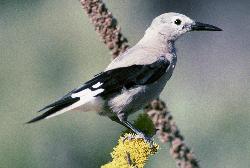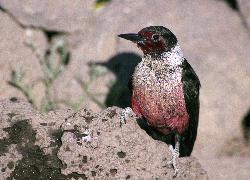
Courtesy US FWS
Dave Menke, Photographer
 Lewis’s Woodpecker
Lewis’s WoodpeckerCourtesy US FWS
Dave Menke, Photographer
Thomas Jefferson will forever be remembered as our third president and author of the Declaration of Independence. Jefferson oversaw the acquisition of the vast Louisiana Purchase and soon thereafter initiated planning for an expedition that would be named the “Corps of Discovery”. That bold adventure was led by Meriwether Lewis and William Clark. These two frontiersmen are immortalized by the plants and animals that taxonomists named in their honor.
The arduous 3-year expedition route passed far north of what would become Utah, ascending the tributaries of the Missouri River and later following down the Columbia River to the Pacific Ocean. Jefferson, being an avid naturalist, instructed the explorers to observe and make record of the geography, plants and animals that they encountered and to return with those specimens which they could carry. Hopes for discovery of a navigable inland passage to the Pacific were not realized, but in all other ways, the expedition was a singular success.
Lewis and Clark made collections of pressed plants along the way. These eventually went to Frederick Pursh, a German botanist in Philadelphia. One new genus of plant he named Lewisia. These are the bitteroots, one of which is the spectacular state flower of Montana. Another genus new to science he named Clarkia . Many species names of plants immortalize the men too, such as the blue-flowered flax, Linum lewisii, commonly used today for seeding following wildfire.
Bird names honoring the discoveries of Lewis and Clark include Clark’s nutcracker and Lewis’ woodpecker. Clark’s nutcracker is a big black and gray relative of crows. [https://wildstore.wildsanctuary.com/collections/special-collections, https://wildstore.wildsanctuary.com/collections/special-collections] This noisy resident of Utah’s mountains is notable for its habit of caching seeds of pine trees to be remembered and found months later.
The age of the pioneer naturalist in North America closed more than a century ago, but the names of men like Meriwether Lewis and William Clark live on with the plants and animals that bear their names.
This is Linda Kervin for Bridgerland Audubon Society.
Credits:
Images: Courtesy US FWS images.fws.gov
Audio: Courtesy & Copyright https://wildstore.wildsanctuary.com/collections/special-collections, https://wildstore.wildsanctuary.com/collections/special-collections
Text: Jim Cane, Bridgerland Audubon Society
Additional Reading:
The Lewis and Clark Herbarium, Images of the Plants Collected by Meriwether Lewis and William Clark, 1804-1806, Presented by the University of Maryland and The Academy of Natural Sciences in Philadelphia in cooperation with Cornell University, https://www.plantsystematics.org/reveal/pbio/LnC/LnCpublic.html
Evans, Howard Ensign. 1993. Pioneer naturalists: the discovery and naming of North American plants and animals. Henry Holt & Company, New York. Illustrated by Michael G. Kippenhan. ISBN: 0-8050-2337-2, https://www.amazon.com/Pioneer-Naturalists-Discovery-American-Animals/dp/0805023372
And for a thorough treatment of Clark’s nutcracker:
https://en.wikipedia.org/wiki/Clark%27s_Nutcracker
All About Birds, The Cornell Lab of Ornithology:
